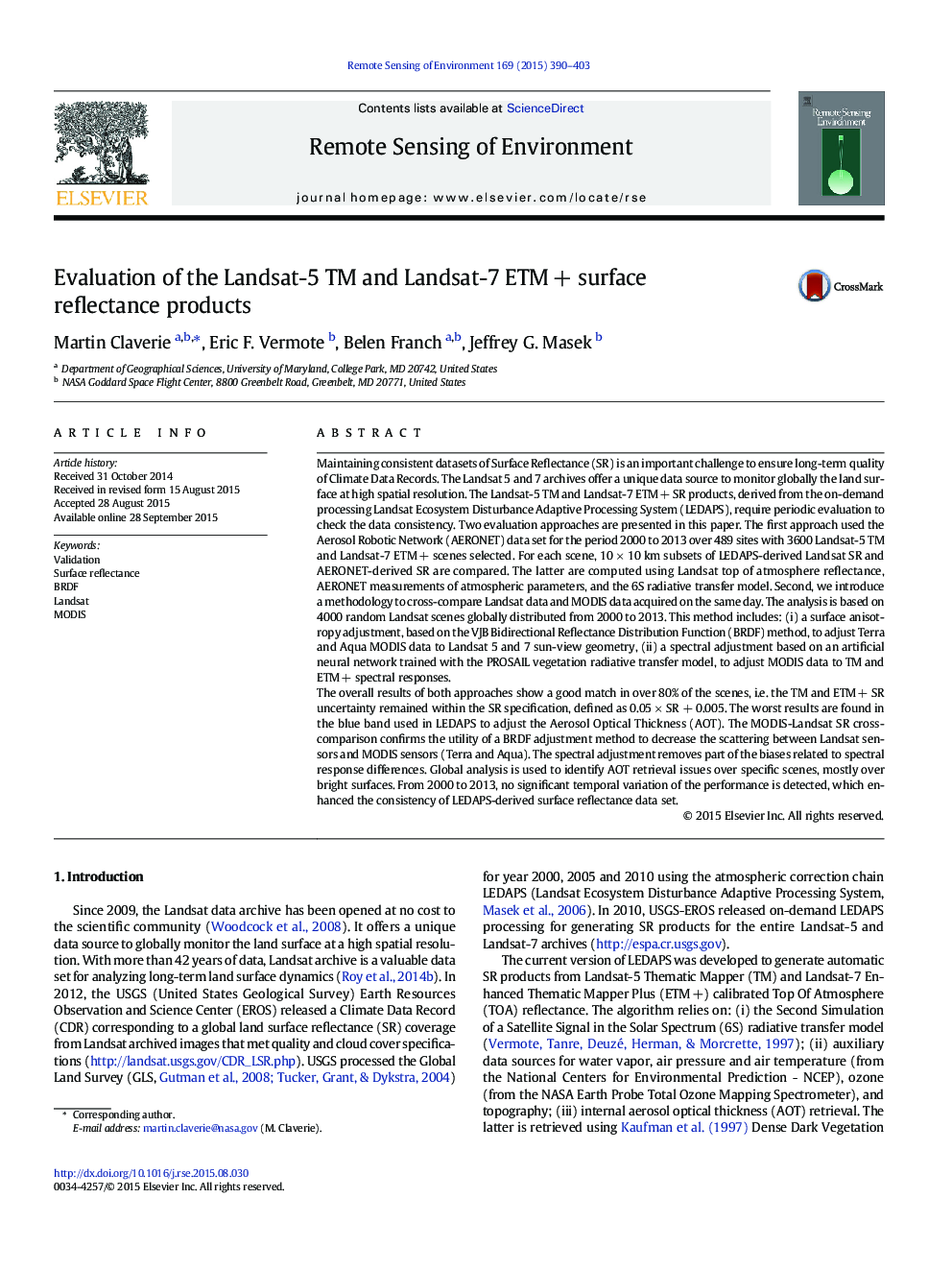| کد مقاله | کد نشریه | سال انتشار | مقاله انگلیسی | نسخه تمام متن |
|---|---|---|---|---|
| 6345848 | 1621231 | 2015 | 14 صفحه PDF | دانلود رایگان |

- We evaluate LEDAPS-derived Landsat-5 TM and â7 ETMÂ + surface reflectance (SR).
- We evaluate the theoretical performances of LEDAPS over 489 AERONET sites.
- We build a methodology to compare MODIS and Landsat SR with BRDF and spectral adjustments.
- The Landsat SR uncertainty is below the specification (0.05ÏÂ +Â 0.005) except for blue band.
- The Landsat SR uncertainty is stable through time.
Maintaining consistent datasets of Surface Reflectance (SR) is an important challenge to ensure long-term quality of Climate Data Records. The Landsat 5 and 7 archives offer a unique data source to monitor globally the land surface at high spatial resolution. The Landsat-5 TM and Landsat-7 ETMÂ + SR products, derived from the on-demand processing Landsat Ecosystem Disturbance Adaptive Processing System (LEDAPS), require periodic evaluation to check the data consistency. Two evaluation approaches are presented in this paper. The first approach used the Aerosol Robotic Network (AERONET) data set for the period 2000 to 2013 over 489 sites with 3600 Landsat-5 TM and Landsat-7 ETMÂ + scenes selected. For each scene, 10Â ÃÂ 10Â km subsets of LEDAPS-derived Landsat SR and AERONET-derived SR are compared. The latter are computed using Landsat top of atmosphere reflectance, AERONET measurements of atmospheric parameters, and the 6S radiative transfer model. Second, we introduce a methodology to cross-compare Landsat data and MODIS data acquired on the same day. The analysis is based on 4000 random Landsat scenes globally distributed from 2000 to 2013. This method includes: (i) a surface anisotropy adjustment, based on the VJB Bidirectional Reflectance Distribution Function (BRDF) method, to adjust Terra and Aqua MODIS data to Landsat 5 and 7 sun-view geometry, (ii) a spectral adjustment based on an artificial neural network trained with the PROSAIL vegetation radiative transfer model, to adjust MODIS data to TM and ETMÂ + spectral responses.The overall results of both approaches show a good match in over 80% of the scenes, i.e. the TM and ETMÂ + SR uncertainty remained within the SR specification, defined as 0.05Â ÃÂ SRÂ +Â 0.005. The worst results are found in the blue band used in LEDAPS to adjust the Aerosol Optical Thickness (AOT). The MODIS-Landsat SR cross-comparison confirms the utility of a BRDF adjustment method to decrease the scattering between Landsat sensors and MODIS sensors (Terra and Aqua). The spectral adjustment removes part of the biases related to spectral response differences. Global analysis is used to identify AOT retrieval issues over specific scenes, mostly over bright surfaces. From 2000 to 2013, no significant temporal variation of the performance is detected, which enhanced the consistency of LEDAPS-derived surface reflectance data set.
Journal: Remote Sensing of Environment - Volume 169, November 2015, Pages 390-403